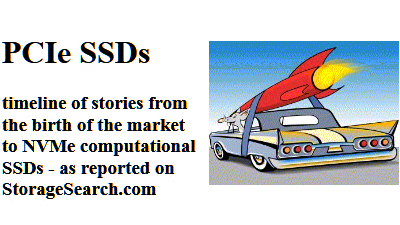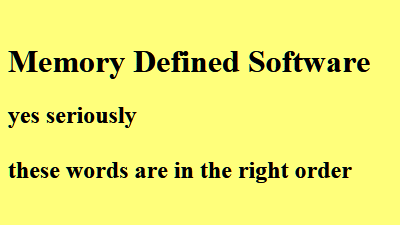how the backup
market moved from tape to
disk - timeline of key
events
by
Zsolt Kerekes
editor of
STORAGEsearch.com
see
also:- Backup
articles on StorageSearch.com from the rotating media era |
In the early days of
the 20th century it was not clear that the car would eventually replace the
horse as the most popular method of powered travel. Horses were cheaper,
more familiar and more reliable than the early generation of petrol driven
cars.
At the turn of the second millenium the
tape backup market had
reached a seemingly unassailable position. 3 out of the top 10 fastest
growing profitable US storage companies in
the first
half of 2001 were tape companies:-
ADIC (40% revenue growth),
Overland (59% revenue
growth) and Qualstar
(40% revenue growth).
But the widespread corporate adoption of the
internet which led to the dotcom bubble was also laying the connection paths
for offsite backup and
replication technologies
which would soon cure the compulsive obsession of manually removing storage
media offsite.
In 2006 the tape market saw its steepest ever decline
in suppliers with
mergers and acquisitions
shrinking the supplier base. The death rattle of the tape backup market has
been heard, although it may survive as a static niche market for a few more
years.
This timeline plots the main markers for the decline of tape and
the storage market switch to D2d.
1987 - the world's first
NAS company
Auspex Systems is
founded. Their first servers were listed in our
SPARC Product Directory in
1992. But it took the industry many years to realise that these products were a
new type of storage server rather than platforms for databases and web servers.
1994
- STORAGEsearch.com's publisher publishes the first directory of
fibre-channel adapters.
That was the start of the network storage market which would later be called
SANs. The market was hotly
contested - and in 1996/97 there were far more oems making FC adapters than
there are today. Many of them advertised in our online directory.
1997
- STORAGEsearch.com's publisher creates an online directory of
RAID systems.
March
2000 - STORAGEsearch.com created a dedicated web page for
online backup and storage.
By this time the internet infrastructure, beefed up to host corporate websites
for the dotcom economy was sufficiently well established to make internet
backup technically viable. Before this era - this type of offsite online backup
was restricted to big corporations with leased data lines using proprietary
technology.
2000 -
FalconStor Software
is founded. The company would later become an important enabler for white box
storage oems entering the virtual tape market.
August 2000 - An
article called - the
Return of Removable Hard Disk Drive Architecture - summarised the state of
the art in SMB disk backup with a comparison of removable storage devices from
leading vendors.
December 2000 -
NAS climbs to equal place
with SAN to reach #5 in
popularity with STORAGEsearch.com's readers.
March 2001 -
STORAGEsearch.com created a dedicated web page for
iSCSI
September
3, 2001 - STORAGEsearch.com ran its first banner ad for a D2d product for
Nexsan Technologies
(see below). |
 |
November 2001 - in an
article called - the Next
Decade in Storage - STORAGEsearch.com precisely foretold the reasons why
D2d would eventually replace tape backup.
March 2002 -
STORAGEsearch.com created a dedicated web page for
D2d
May
2002 - ads on STORAGEsearch.com's main D2d page were split 50:50
between new D2d systems and tape
libraries as you can see on the archived page.
December 2002 - in
STORAGEsearch.com's year end review -
SATA was named
Product Category of the Year - based on reader pageviews. SATA hard drives
provided a step change in capacity and system cost which later helped to
accelerate the D2d market.
February 2003 -
the first recorded occurrence of the term VTL (virtual tape library) appears in
a joint news story by MTI
Technology and Quantum.
April
2003 - STORAGEsearch.com
reported on May 5, 2003 that reader pageviews for
disk to disk backup in
April 2003 exceeded pageviews for
tape backup for the first
time. "We're now at a watershed where users no longer have to choose tape
just because their forebears did" - said editor Zsolt Kerekes at the time.
October 2003 -
StoneFly Networks and
CommVaultSystems
launched a bundled D2D backup IP SAN system that starts at $33,995 for a 1TB
solution.
November
2003 - commenting on the launch of its new ATAbaby disk array
Nexsan's Senior
Executive Vice President Diamond Lauffin said "The new ATAbaby Twins is
another nail in the coffin of tape-based backup. No tape loader or library can
deliver the same level of data protection and availability at anywhere close to
this price."
January 2004 -
COPAN Systems
summarised the current state of the tape - verses D2d market. "Unfortunately,
even with the advent of the new SATA disk systems at $10/GB, disk is still three
to five times the cost of automated tape libraries making long term data
management prohibitive. In addition, many enterprises are concerned with the
reliability of SATA technologies."
August 2004 -
Peripheral Concepts
published the results of their
market research into
backup practises and
plans in over 1,000 major IT sites. The report said:- "The population
using disk in backup has grown to 62%, and is forecast to reach 76%
penetration by 2005."
December 2004 -
Engenio published an
article called - Disk
to Disk Backup versus Tape - War or Truce?
Commenting on this
STORAGEsearch.com said "Will disk to disk backup make tape backup obsolete?
That's a question that's been debated hotly here on STORAGEsearch for many
years. At the extreme polarized ends of the argument are tape media makers like
Sony, who in
an article here made a
case for the long term survival of tape, and at the other end of the argument
are disk to disk supporters like STORAGEsearch whose
editorial view (March 2004)
has been that tape doesn't have a viable role the midsize market any more.
March
2005 - Quantum
became the first major storage vendor to include data compression within a D2d
product when it added its Optyon hardware based data compression technology to
the DX-Series disk-based backup systems enabling 2T / hour backup performance.
In addition to the cost savings compared to uncompressed solutions - an
additional benefit is increased
storage reliability
for customers. Because they only need half as many
disks in their disk
backup population.
Overland claimed to
be the #1 company in disk to disk backup, saying it had shipped more disk-based
backup appliances than any other vendor:- more than 1,000 of its own REOs. I was
sceptical about this leadership claim - but no one contested it at the time.
October 2005 -
MaXXan Systems
published an article called -
Virtual Tape: Can You
Afford to Ignore It?
Commenting on this STORAGEsearch.com said "Some
of the growing sophistication in the market can be seen by the way that the
marketing terminology has morphed from the early D2d (let's kill tape backup)
to the current VTL (Virtual Tape Library - let's just see if they notice that
it's more reliable and works faster - and don't tell them that there isn't a
tape in the box) type of approaches."
May 2006 - in a
white paper called "Total Data Protection" - Farid Neema, President
of Peripheral Concepts
wrote - "For the first time ever, more than one half of the surveyed
managers consider the possibility of a tapeless IT operation in the long
run. This aspiration for "getting rid" of tapes is even more
pronounced in very large IT operations. In 2006, there will be more data backed
up on disk than on tape, and disk should gain 4% share every year for the next
three years."
August 2006 - D2d became the 4th most
popular subject viewed by STORAGEsearch.com's readers (up from #15 in July). I
commented - "Recent months have seen a spate of mergers and revenue
attrition in the
tape backup market - and
the sharp increase in D2d content may signal that users no longer give credence
to all the brave bullish talk they've been hearing from tape backup companies.
September
2006 - D2d became the 2nd most popular subject viewed by
STORAGEsearch.com's readers.
October 2006 - D2d became the #1
most popular subject viewed by STORAGEsearch.com's readers. ...later:- and
it remained #1 for the next 8 months too - upto and including May 2007.
Also
in
October 2006 - Network
Appliance added data compression to its Virtual Tape Libraries.
December
2006 - D2D was named STORAGEsearch.com's Product Category of the Year
2006. In Q406 there was a surge of interest in
D2D - which accounted for
more reader pageviews than the next two subjects added together, despite
annual pageview growth over 50% in those subjects too. "These results
predict a stunning growth year for the disk to disk backup industry in
2007" said Zsolt Kerekes, editor
STORAGEsearch.com.
January 2007 -
Hitachi announced the
industry's first terabyte hard drive priced at about 40 cents per gigabyte.
March
2007 - Enterprise Strategy
Group quoted from their
VTL
Adoption and Market Trends Report that "85% of VTL users have already
eliminated tape from their daily backup schedules."
April 2007
- STORAGEsearch.com reported that
tape backup related searches had dropped out of the top 20 subjects viewed by
readers in the preceding month.
June 2007 -
Idealstor announced
it had certified Hitachi's
new terabyte hard disks for use with its Teralyte removable disk backup
system.
November 2007
- NetApp's CEO Dave
Hitz said in his blog this month "...I'm surprised how important creating
real tapes from the VTL has remained. Despite all the hoopla about disk-to-disk
backups, 80% of VTL customers still rely on tape for some part of their process."
December
2007 - Disk to Disk Backup is named STORAGEsearch.com's Product Category of
the Year 2007 - for the 2nd year in a row.
July 2008 - The
first enterprise storage product to apply disk backup techniques to a
flash SSD array
was announced by Texas
Memory Systems. The RamSan-440 - a 4U rackmount
RAM SSD automatically
backs up and restores its 512GB of fast SSD storage in 6 minutes (compared to
2 hours with an internal hard disk protected system.)
April 2009
- 2 troubled tape library makers reached their nadirs.
- Sun Microsystems was
acquired by Oracle
for for approximately $7.4 billion. (Which is similar to Sun's own total spend
on acquiring storage
companies. Thereby valuing Sun's server business as zero - or vice versa.)
August 2009 - 2TB 3.5" 7,200 RPM
hard drives from
Hitachi and
Western Digital
started to appear in high density enterprise disk arrays from multiple vendors.
October
2009 - Sony warned
users that it was - at long last - end of lifing
AIT
drives - and they would no longer be available after March 2010.
November
2009 - Axxana
announced it has secured $9 million
Series B investment led by Carmel
Ventures. The funds will be used to accelerate the adoption of
The Phoenix System
- a lossless data recovery system which sits on the
SAN and records data into a
rugged flash
SSD-enabled, locally situated, data survival box.
December
2009 - Symantec
announced an upgrade to its Storage Foundation management software which
enables it to
automatically
discover SSDs from leading vendors and optimize data placement on
SSD devices transparently.
January 2010 -
ioSafe launched the
ioSafe Solo SSD - an ultra rugged USB
/ eSATA external flash SSD with upto 256GB capacity ($1,250) designed to
provide data protection against disasters such as fire, flood, and building
collapse.
March 2010 -
StorageSearch.com published a
futuristic article - this
way to the petabyte SSD - which explained why due to cost factors like
electrical energy and floor space it was inevitable that solid state storage
arrays would one day become cheaper to own and operate for lower latency mass
storage uses compared to hard drives despite the higher cost of flash media and
even if hard drives were free! (zero cost to buy). In the 8 years
following publication - this petabyte SSD article was updated with a timeline
of critical news stories from the
storage news
archive which showed milestones towards the petabyte SSD array as a low
cost storage systems and showing how right and wrong the original predictions
had been, |
|
| See also:-
|
|

| |
|
|
|
|
| . |
 |
| . |
|
|
|
| . |
The
History of Disk to Disk Backup in the Small Business and Home Workplace Market
The
5.25" hard drives used in the early days of the IBM desktop PC (1982) were
too delicate to be any use as removable backups. For most of the 1980s even the
process of installing a new 5.25" drive could destroy it, unless you took
precautions and had shock absorbent material on your work bench. But a new
generation of more rugged disks was evolving in parallel.
In 1983 the
newly formed
Compaq Computer launched
the first IBM PC compatible portables. These used the new style of 3.5"rugged
disk drives from Connor
Peripherals which were better able to survive shock and vibration. Initially
more expensive than other drives, they had the added advantage of taking up less
space and a lower dead on arrival rate for systems integrators.
However,
during most of the 1980s the cost and unreliability of
removable hard drives
prevented them from being widely used as a backup medium. The exception was
the military. Special
shock absorbent elastometric shuttles were designed to enable disks to be used
in high vibration environments and to be easily removed and locked away for
security reasons. The problem was that the shuttles cost more than the disk
drives and were out of reach of most users' budgets.
During the early
1990s, backup for most home PC users (if they did it at all) meant using
multiple floppy disks.
In 1995
Iomega simplified this
process with the launch of their
Zip drive. The Zip drive
offered the equivalent storage capacity of about 100 floppy disks on a single
super floppy. A few years later the Jaz drive, a 1G byte removable disk with
rugged handling characteristics provided one of the first examples of true
affordable disk to disk backup.
By the year 2001 the newest generations
of
hard drives designed
for portable PCs and cameras were rugged enough to use as external backup
devices with little or no additional mechanical protection. Connecting simply
via USB or
Firewire, an external
hard disk backup became the cheapest form of backup device for the home
workplace. Dozens of hard
disk manufacturers such as
Western Digital now
supply these solutions with integrated software.
See also:-
FireWire storage,
Removable disk drives,
USB storage | |
| . |
SSDs Pass HDDs
in Storage Density
2009 may well
be remembered as the year that flash
SSDs surpassed HDDs
in storage capacity in the same form factor.
I'm not talking about itsy
bitsy
1 inch and smaller drives
here. I'm talking about the hard core
2.5" form factor.
That's
the size which once seemed to offer the
best hopes
for hard disk makers staying in business - in applications like disk to
disk backup, entertainment
bulk storage etc.
In January 2009 - pureSilicon started
sampling a
2.5" MLC SSD -
with 1TB capacity in a 9.5mm high form factor.
A few weeks later
Western Digital
temporarily restored the parity in storage density when it announced a
2TB
3.5" hard drive. Since you can put 2x 2.5" drives into a single
3.5" enclosure - you
can think of them as being equivalent. That is until either the next
amplification in MLC (if it ever
works) or the next shrink in flash memory (maybe
later than sooner).
Price of the 2.5" terabyte SSD wasn't
mentioned. I expect it will cost a lot. But nowhere near as much as the 1st
terabyte SSDs cost - when they appeared in
2002 - at
a cool $2 million.
So you may well ask - when will SSDs cost less
than HDDs for the same capacity?
In some high-performance grades (15K
RPM server drives) - I expect to see that happen this year - in smaller
capacities like 100GB. Looking Ahead to the
2009 SSD Market | |
. |
 |
.
. |
 |
.
. |
|
|
|
| |






